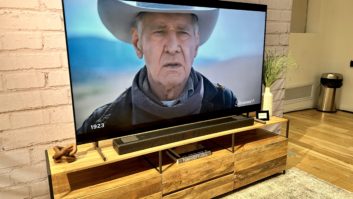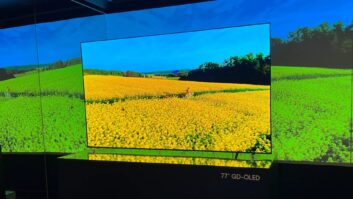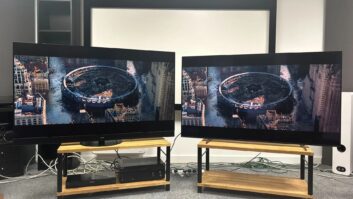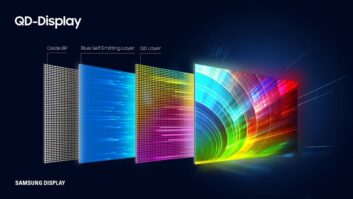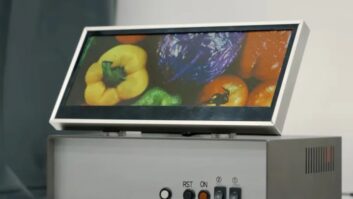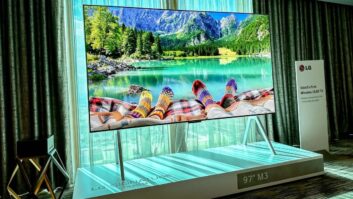Following its decision to exit the rear-projection TV category, Sony travels to International CES with an arsenal of new LCD TVs and the company’s first OLED TV for the U.S. market.
Sony is launching here 14 Bravia LCD models, including slim-bezel and thin-depth cabinets, as well as Sony’s new 3-D graphic user interface integrated with TV Guide programming information.
Many models will also have the ability to access video from select portable media devices such as Walkman and iPod players via optional Digital Media Port (DMP) accessories, as well as access to digital photos and music via USB devices.
Additionally, XBR6 and Z-series models will be compliant with Digital Living Network Alliance (DLNA) networking systems.
Sony said its product strategy this year is to provide products that allow users to access different types of content not only through the Bravia Internet Video Link module introduced last year, but through the new DMP, USB feature and DLNA networks.
Another new feature in many sets is what Sony calls DMeX, which will allow current and future Sony Bravia TV users to integrate a module for the Internet Video Link, and to add additional modules down the line. All the modules will integrate into an XMB graphic user guide, enabling upgradeability as new technologies evolve, the company said.
In addition, Sony will introduce what is expected to be the first OLED TV set for the U.S. market.
Model XEL-1 (available this month at a $2,500 suggested retail) is an 11-inch OLED TV with a panel depth of just 3 mm (0.11 inches). The display is said to produce a contrast ratio of 1,000,000:1, supporting very deep black levels and a new level of color presentation and picture detail.
In addition to affording very thin panels, OLED technology is said to allow extremely bright pictures with low power consumption, a rapid panel-response time for blur-free motion images and extremely wide viewing angles.
Currently, OLED will only afford relatively small screen sizes, but the technology is expected to evolve rapidly. One of the difficulties in developing OLED for TV was said to be limited longevity under high temperatures, but Sony executives said that panel life for the XEL-1 is comparable to LCDs.
Among the Bravia LCD TVs Sony is introducing are a 32- and 37-inch models in the high-end XBR 6 series. The KDL-32XBR6 and KDL-37XBR6 will ship this summer at prices to be announced. Both feature 1080p resolution, 120Hz MotionFlow high frame-rate technology, DLNA compliance, DMP connection, 24p input compatibility, a 3D graphic user interface, DMeX ready, and four HDMI inputs, two component video inputs and a PC input. Both are also Bravia Sync (HDMI-CEC) capable.
The Bravia Z4100 series shipping this spring will include models in the 40- and 46-inch screen sizes. Both feature ultra-slim bezels and thin cabinet depths.
Both Full HD 1080p resolution, 120Hz MotionFlow frame rates, 24p input, 3D graphic user interface, DMeX capability, and four HDMI inputs, two component video inputs and a PC input. Both are also Bravia Sync (HDMI-CEC) capable.
The three models in W4100 series will ship this spring, and include the 40-, 46- and 52-inch screen sizes. All will have Bravia Engine 2 signal processing, 1080p resolution, 120Hz MotionFlow frame rates, 24p input capability, a 3-D graphic user interface and DMeX capability, as well as and four HDMI inputs, two component video inputs and a PC input. All are also Bravia Sync (HDMI-CEC) capable.
The V4100 series models shipping this spring will including the 40-, 42-, 46- and 52-inch screen sizes. All include 1080p resolution, high-definition 3-D graphic user interface, Bravia Engine 2 Digital signal processing, Digital Media Extender (DMex) capability, and four HDMI inputs, two component video inputs and a PC input. All are also Bravia Sync (HDMI-CEC) capable.
The Bravia M4000 series will ship this spring and includes the 19-, 26-, 32- and 37-inch screen sizes. All offer 1,366 by 768 HD resolution, except the 19-inch model which is 1440-by-900. They use the Bravia Engine Digital signal processing system to convert imported signal sources and have two HDMI inputs, and are Bravia Sync (HDMI-CEC) capable.




